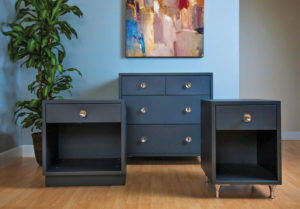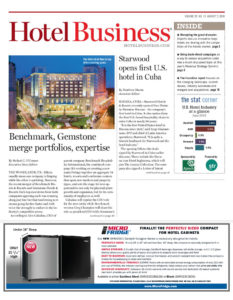FOUNTAIN VALLEY, CA—Stainless steel has been a mainstay in kitchen cabinetry, but within the past year, this option has gained considerable momentum in casegoods. Stainless steel paired with warm wood tones, natural elements and pops of color have been trending in kitchens across the country.
While steel was the material of choice for kitchen cabinetry at the turn of the 20th century due to its durability, cleanliness, sustainability and nontoxic properties, a new iteration of steel cabinetry is emerging in hospitality interiors. Moya Living, through parent company Genie Scientific Inc., has designed and built powder-coated steel casework, which was previously exclusive to the laboratory industry, with all the accessories and hardware of a modern home.
Now the Fountain, Valley, CA-based manufacturer of custom, powder-coated steel kitchens and furniture is attempting to redefine guestroom interiors with a line of made-to-order steel casegoods that strive to unite expert craftsmanship with aesthetically pleasing designs.
While steel cabinetry has been associated with industrial and utilitarian design aesthetics, Laguna Beach, CA-based artist and designer Moya O’Neill, cofounded Moya Living in an attempt to bring contemporary design to a classic concept. The line is available in a wide variety of colors, and in matte, gloss or hammered finishes.
The steel furniture and cabinetry line also strengthens the company’s commitment to sustainable practices. Steel casegoods are nontoxic and hypoallergenic, contributing to cleaner air indoors—a vital consideration for hospitality environments.
Steel and steel-construction processes do not contain formaldehyde, a known carcinogen commonly found in particleboard, plywood and fiberboard products used in wooden cabinetry and furniture, according to Moya Living. As these materials interact with sunlight, formaldehyde is released into the air.
According to the U.S. Consumer Product Safety Commission, formaldehyde exposure may potentially cause a variety of symptoms and adverse health effects such as eye, nose, throat and skin irritation, coughing and wheezing, and allergic reactions. Long-term exposure to high levels of formaldehyde has been associated with cancer in humans and laboratory animals.
n hospitality environments, where occupancy changes frequently, the sterility and hypoallergenic properties of steel are an asset, according to O’Neill. “As hotels look to achieve green status, there is a compelling ecological case for steel as well,” she said. “Steel is North America’s top recycled material and can be repurposed multiple times without losing durability. In addition, steel is nontoxic and absent of formaldehyde, which is commonly used in wood or laminate products.”
Conversely, Moya Living steel cabinetry and furniture is welded and does not use formaldehyde-laden glues, enabling cleaner indoor air quality, according to the company. “Furthermore, because steel is impermeable, allergens are unlikely to take root, and it is also a less likely home for pests,” O’Neill added.
Additionally, steel is North America’s top recycled material. More is recycled in the U.S. than paper, plastic, aluminum and glass combined, according to the Steel Recycling Institute. When one ton of steel is recycled, 2,500 pounds of iron ore, 1,400 pounds of coal and 120 pounds of limestone are conserved. Around 90% of water used in the steel industry is cleaned, cooled and returned to source, according to the World Steel Association. Most of the loss is due to evaporation.
For the hotel industry, the durability of steel affords a lower total cost of ownership by almost eliminating the need to repair or replace, according to the company. Steel cabinetry and furniture are more resistant to impact, moisture, chemicals, ultraviolet light and extreme weather than wood and lacquered products. Additionally, high- quality steel furniture, finished with a powder-coating process, would reduce the risk of scratching, chipping, corrosion, fading and other wear issues.
“There is a strong desire among forward-thinking designers and clientele to consider earth and health equally as much as beauty,” said O’Neill. “What steel has to offer in kitchen and bath applications—a balance of function and durability with beauty and warmth—truly sets it apart from a design perspective.”
For hotel guests and housekeeping, the concept of cleanliness from steel offers an attractive consideration. “Functionally, steel offers heightened sterility and cleanliness over wood or laminate items,” said O’Neill. “Steel can been cleaned effectively with nontoxic cleaners—a safer choice for guests and workers. From a design standpoint, steel furniture is all about clean lines that create a seamless and cohesive flow in the overall design of the room.”
Some of the common misconceptions of casegoods made from steel are the product is too industrial in appearance and creates noise when in use, similar to a metal filing cabinet, observed O’Neill. She disputes these claims noting that Moya Living’s product designs would fuse with any design aesthetic. She added, “Our products have a core filling that make the pieces remarkably quiet when in use, which is a huge asset for a hospitality environment.”
The design potential with steel cabinetry and furniture is vast for the industry. “In hotel use, designers can incorporate steel furniture as a focal point, choosing a bright statement color, or to achieve sleek, integrated aesthetic,” said O’Neill. “Designers can create a unique look through virtually limitless combinations of color, finish and hardware.” HB


